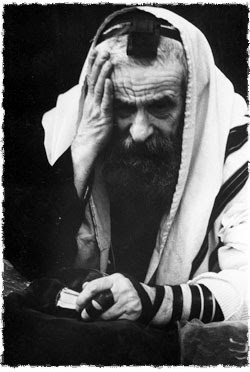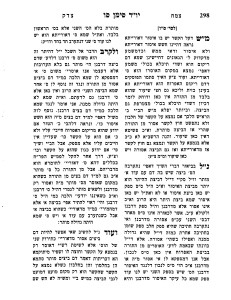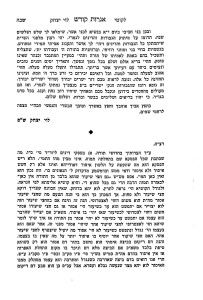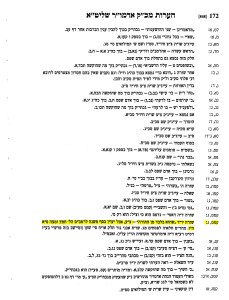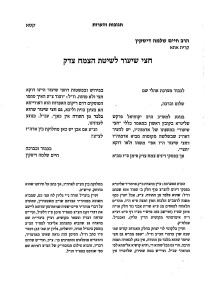Makos 16b (2)
- The Gemara we learned speaks about the concept of Produce that needs to be tithed. There are five types of tithes that need to be given:

Truma – 2% from the Yisroel to the Kohen.
Ma’ser Rishon – 10% from the Yisroel to the Levi.
Trumos Ma’ser 10% from the Levi to the Kohen.
Ma’ser Sheni- 10% for the Yisroel’s personal use to be eaten in Yerusholayim only.
Ma’ser Ani- 10% from the Yisroel to the poor and needy.
Until the all of first four of the above are set aside or given away the produce is definitely considered Tevel.
The question in our Gemara was whether the ‘Lav’ of eating Tevel applies also to produce that is only lacking the giving of the last Tithe, Ma’ser Ani. # 5 above.

We discussed the physiological mind-set of simple farmers of old (times of the Tannaim) that would sell their produce as ‘Kosher’ when in reality only the Truma would be given by them. The other 3 or 4 tithes would be inside the produce despite their claim to the contrary.
Their reasoning was that people were not suspected of causing someone to eat Truma; this is something they were not comfortable with. On the other hand withholding Ma’ser from the Levi (stealing in other words) is something that they could live with….
Mentioned also was the famous opinion of Rashi that the prohibition of Tevel is because of the Truma that is in the Tevel prior to the removing the Truma.
(Yevamos 86a, Rashi, and Tosafos “Ma Toveles”, and R’ Y Engel, Asvun D’oraisa, klal 2 here)
2. We mentioned an interesting idea pertaining to this weeks Parsha about the “Azazel” – the scapegoat.

On Yom Kippur 2 male goats would be selected and a Goral performed to choose the one to be sacrificed on the Mizbe’ach and the other to be sent to Azazel.
The Kohen Gadol confessed the sins of the people while laying his hands on the head of the goat which was sent out to Azazel in the wilderness.

The word Azazel is what philologists call a ‘hapax legomenon’. It is un ique, found only in this passage; and therefore, its meaning cannot be easily deduced by comparing it with its usage in other places. The word sounds vaguely like a proper name, similar to names of supernatural beings that appear in Jewish mystical texts.
ique, found only in this passage; and therefore, its meaning cannot be easily deduced by comparing it with its usage in other places. The word sounds vaguely like a proper name, similar to names of supernatural beings that appear in Jewish mystical texts.
A most intriguing attempt to explain the text is provided by Rabbi Abraham Ibn Ezra. He writes cryptically:
And if you were capable of grasping the mystery of the word Azazel, then you would know its secret and the secret of its name, for it has equivalents elsewhere in the Bible. I shall reveal to you a portion of the mystery, only by way of an indirect hint. When you reach [the age of] thirty-three you will know it.
What did the Even Ezra mean with this “33” code?
The Ramban deciphers it.
He justifies his indiscretion by claiming that Ibn Ezra’s mysterious secret is not a secret at all, and merely refers to an interpretation that was well known from the Talmud and Midrash. According to the Ramban, the thirty-three does not designate a minimum age, but rather the number of verses that we are instructed to count until we arrive at the key to the solution. Do the math, and you will arrive at 17:7. The Torah talks about the prohibition against bringing any offering off-site; not in the Beis Hamikdash.
And they shall no more sacrifice their sacrifices unto the satyrs [demons], after whom they go astray.
That is what the Even Ezra meant to say- count 33 verses ahead and you arrive at the prohibition on dealing/offering to demons- a practice common in the post-Egyptian era.
He equates both Azazel and the satyrs with tangibly demonic forces of evil. Azazel = satyr = goat = Se’ir = Esau = Sam”mael = the lord of metaphysical wickedness. Hence, the Torah is advising us that, though at all other times of the year we are supposed to be occupied in a relentless war against Azazel and his evil minions,
Only on the Day of Atonement, has G-d commanded us to buy them off with a generous offering of a sin-bearing goat, because the goat is Sammael’s favorite animal.
It a mystical explanation. True. But he does crack the code of the Even Ezra.
There are other explanations on the 33 mystery. Here is one.
The Torah, with the commandment to ‘send away the goat to Azazel in the desert’, means to drive home the point that sorcery and witchcraft are out of the realm of the Jewish religion.
The Gemara in Sanhedrin (105a) says that the great sorcerer of all times was Bilam. His power was [in a sense] derived from sorcery. His life span was shortened due to his shortcomings etc. He was killed at the age of 33 (106b)!
And that is what the Even Ezra meant.
Nu nu. A bit of a stretch.

We mentioned another attempt at cracking the number 33…but it is so ridicules that it’s not worth writing….

…you say a dude was trying to throw you off of what now?
